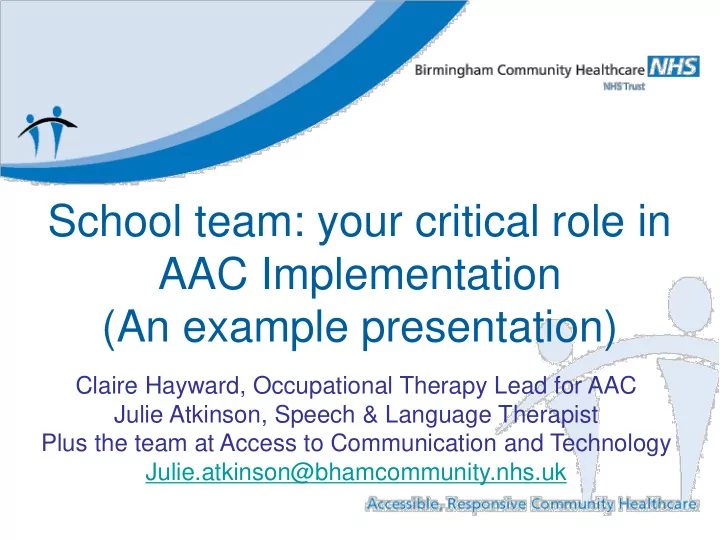

School team: your critical role in AAC Implementation (An example presentation) Claire Hayward, Occupational Therapy Lead for AAC Julie Atkinson, Speech & Language Therapist Plus the team at Access to Communication and Technology Julie.atkinson@bhamcommunity.nhs.uk
Outline of the session • What is AAC? • Awareness of the overarching principles that contribute to the success of AAC • Signpost to useful resources • Practice modelling low tech • Time & space to think & discuss & plan
Use an example from their Ofsted / CQC report “Consider how to bring together elements from the work on improving communication with elements from the mental health project to best support the pupils with the most complex needs to communicate their feelings and concerns ”
Key Message & Principle:
Augmentative & Alternative Communication (AAC) • Any system that is used TO and BY someone who doesn’t use speech as their main form of communication • The form of AAC used varies with need • Language is represented by objects, photos, pictures, symbols, written words, signing • It can be any combination of: – No tech – Low tech – Medium tech – High tech
What is Low Tech? “Low -tech communication systems do not need a battery to function and include: • pen and paper to write messages or draw • alphabet and word boards / books • communication charts or books with pictures, photos and symbols • particular objects used to stand for what the person needs to understand or say” http://www.communicationmatters.org.uk/page/what-is-aac
Types of low tech ACE resources Makaton Core Vocab
Least Dangerous Assumption 1 We can never really know what a person is capable of until we provide them with the opportunity to learn and show us
Presuming competence - No prerequisites - Will become competent if we use it - Consistently & for the long term - ASAP - Replicating an ordinary acquisition pathway - While working on other things the child might need http://praacticalaac.org/video/presuming-competence-and- using-the-least-dangerous-assumption/ (30 min video) Donnellan, A. (1984). The criterion of the least dangerous assumption. Behavior Disorders, 9, 2, 141-150.
“ Consistently” = A Language System 2 A child using speech will independently select the words she wishes to use from the vast array of words she hears used every day. A child using AAC will independently select the words she wishes to use from the vocabulary other people have chosen to model and for aided symbols, made available for her to use
Language System - Readily available - A way of initiating communication - “I’ve got something to say” - Motor pattern – stay in the same place - Core words, not just nouns - It’s about language generation - Autonomy of message - Don’t be a ‘gate keeper’
Core Vocabulary 3 Core is more
Core Vocabulary • 400 high frequency words that make up 80% of the words we use Van Tatenhove, 2009, Witkowski & Baker, 2012 • Are most common in early language development • Need a shift in questioning approach (descriptive teaching rather than direct / referential questioning) • ‘Language stealers’ video https://www.youtube.com/watch?v=iOVm8q0mCYA
Core vocab game (to practise using core vocab)
Modelling Language is 4 caught not taught
• OR:
Learning language with an added way 1
Learning language with an added way 2
Modelling https://www.youtube.com/watch?v=flFNMky22-U
‘Smart’ Partner • Use modelling • Establish habits the child can copy • Mistakes happen! • Make it about the language not the motor skills • Let the child lead • Clarify • Motivate & have fun! https://www.youtube.com/watch?v=tz6QY- wPGA0
Using a Communication book • Using the book provided, tell your communication partner something that they don’t know about you • … but I can’t find the words!!!! – This is what our children have to do when we give them a beautiful new book or communication aid that they have never seen before! – Hence the need for you to know their books and model it to them
What next? • AAC policy in school? • Shared learning sessions? • Training from your hub?? • Request to Senior Management Team / SLT team for more support? • Revisit EHCPs and goal setting • Look at links below • And MODEL AAC!!!
Takeaways • AAC is not optional, it is critical • Get the book or device out at all times • Talk naturally, pointing as you would sign • Value low tech • Plenty of carrots, plenty of sticks
Further information • Communication Matters • We Speak PODD youtube channel • Uncommon Sense Facebook Page • AAC SIG Facebook Group • http://praacticalaac.org/ • http://www.1voice.info/ • https://ilc.com.au/wp-content/uploads/2014/12/Top- tips-for-implementing-AAC.pdf
References • Van Tatenhove, G. (2009). Building Language Competence with Students Using AAC Devices: Six Challenges. Perspectives on Augmentative and Alternative Communication, 18(2) , 38-47. • Witkowski, D., & Baker, B. (2012). Addressing the content vocabulary with core: Theory and practice for non-literate or emerging literate students. Perspectives on Augmentative and Alternative Communication, 21 , 74-81.
Feedback • Questions? • Comments? • Feedback forms • Certificates THANK YOU
Recommend
More recommend